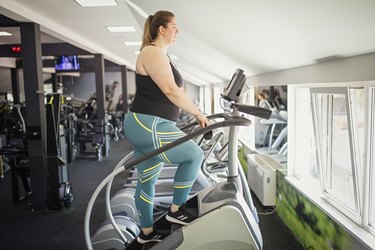

Anyone that tells you they love the stepmill is probably bluffing (at least a little). After all, the general disdain for stairs is why elevators were invented, right? But in the stepmill's defense, this piece of equipment is excellent for building muscle, burning calories and building cardiorespiratory fitness.
Yep, regular stair climbing can help boost your heart and lung health, according to a September 2019 study published in Preventative Medicine Reports. It's can also be beneficial to your bone health, helping increase your bone density, especially in post-menopausal people, according to Duke University. Plus, stair climbing can help support healthy joint and muscle function.
Video of the Day
In comparison to other forms of exercise, the stairs are pretty tough to beat. When measured against walking, stair climbing is the more demanding exercise, according to Harvard Health Publishing. Climbing stairs is twice as difficult as brisk walking and 50 percent more challenging than walking on an incline.
"I personally prefer the stair machine because it allows me to keep my heart rate higher through the entire session, increasing the cardiovascular challenge," says Carolina Araujo, CPT, a California-based certified personal trainer. "It is also a great way to help lean out the lower body."
If you're looking to get an all-over burn in a short amount of time, try Araujo's HIIT stepmill workout. It combines stepmill intervals with some of the best body-weight exercises to get your heart bumping and muscles firing.
Do each round in order, repeating twice before moving on to the next one.
Check out more of our 20-minute workouts here — we’ve got something for everyone.
Round 1: Stairs + Thrusters
Move 1: Stepmill: Climb at level 6 for 1 minute.
Move 2: Stepmill: Climb at level 8 to 10 for 1 minute.
Move 3: Dumbbell Thruster
- Lift your chest, push your hips back and bend your knees.
- Squat down until your thighs are parallel to the floor.
- Explosively drive up and out of the squat.
- Maintain the momentum of the bar by powerfully extending your arms and pushing it overhead to arms' length.
- Bend your arms and lower the bar back to your shoulders before squatting down and repeating.
Tip
To make your thruster even more challenging, you can add a pulse to the bottom of your squat, coming up halfway and dropping back into the full squat.
Round 2: Stairs + Push-Ups
Move 1: Stepmill: Climb at level 6 for 1 minute.
Move 2: Stepmill: Climb at level 10 to 12 for 1 minute.
Move 3: Push-Up
- Begin in a high plank, hands directly beneath your shoulders, legs straight out behind you. Avoid sagging or hiking your hips and try to keep your body in a straight line from head to hips to heels.
- Keeping your elbows at about a 45-degree angle from your ribs, bend at the elbows and lower toward the ground until you hover close to the floor.
- On an exhale, press back to high plank.
- Repeat this move for 30 seconds.
Tip
If standard push-ups feel to challenging or if you begin to fatigue before the 30 seconds are up, drop to your knees and perform a modified version of this exercise. Keep your hips in line with your shoulders.
Round 3: Stairs + Jump Squats
Move 1: Stepmill: Climb at level 6 for 1 minute.
Move 2: Stepmill: Climb at level 10 to 12 for 1 minute, skipping every other step.
Move 3: Jump Squat
- Begin with your legs at shoulder-width apart, arms at your sides.
- Lower into a squat, sending the hips back and bending at the knees. Keeping your back flat and shoulders back and lower until your thighs are parallel to the ground.
- On an exhale, jump up into the air, swinging your arms up to gain momentum.
- Land back into your squat and rebound quickly back into the air.
Tip
If the standard jump squat is too challenging, you can perform squat pulses instead. As you squat, come halfway up to standing, then lower back down to the full squat. Pulse here for 30 seconds.
Round 4: Stairs + Wall Sit
Move 1: Stepmill: Climb at level 8 for 1 minute.
Move 2: Stepmill: Climb at level 12 to 14 for 1 minute, skipping every other step.
Move 3: Wall Sit
- Lean against a wall with your back flat.
- Bend your knees, keeping your back against the wall, and lower into a squat.
- Lower until your thighs are parallel to the ground and pause here for 30 seconds.
- Keep your arms at your sides and avoid placing your palms on your thighs for extra help
Tip
To make your wall sit more difficult, loop a resistance band around your legs above your knees. Or hold two dumbbells in your hands and perform biceps curls for a full-body exercise.
- Preventative Medicine Reports: "Associations of self-reported stair climbing with all-cause and cardiovascular mortality: The Harvard Alumni Health Study"
- Duke University: "Benefits of Taking the Stairs"
- Harvard Health Publishing: "Walking: Your steps to health Exciting benefits of walking for heart health"